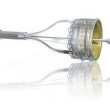The current guidelines point out a class I recommendation to the use of distal embolic protection devices for angioplasty in venous bridges, in fact, the evidence is controversial to support this recommendation. The goal of this meta-analysis was to compare mortality from any cause, major cardiovascular events, acute myocardial infarction, and target vessel revascularization of...
The 10 Commandments of ESC’s New STEMI Guidelines
The authors have given an entertaining account of the most relevant points and differences between the new STEMI guidelines and the prior ones, from 2014. The article features 10 points resembling the ten commandments, which makes it easy to read, compared to the tedious task of reading the complete guidelines. 1) The emergency systems should help...
OCT Follow-Up of Plaque Erosion with Medical Therapy and Without Stenting
Most acute coronary syndromes (ACS) are caused by the following three different pathologies: Plaque rupture Plaque erosion Calcified nodule In daily clinical practice, all patients who experience them are treated with angioplasty, regardless of which of these physiopathologies led to the ACS in each case. Some early reports indicate that patients with plaque erosion might...
WIN TAVI: The Largest Female TAVR Registry So Far
Courtesy of Dr. Carlos Fava. In most randomized or observational studies, women comprise more than 50% of patients undergoing TAVR, and they have showed better evolution, compared against surgery. The main differences between men and women with severe aortic stenosis are that women have smaller annular dimension, shorter distance to coronary ostia, smaller peripheral arteries, and...
The 9 most read scientific articles of 2017 in interventional cardiology
1) New High Blood Pressure Guidelines The wait is finally over: the high blood pressure guidelines that have been in the works for the past 3 years saw the light of day at the American Heart Association (AHA) 2017 Scientific Sessions. Read more 2) Nearly half of interventional cardiologists may have pre-cataract lesions This statement is based on eye...
Important Study Suggests that Rotational Atherectomy Is Feasible with Transradial Access
Rotational atherectomy is a very important tool in the treatment of heavily calcified and non-dilatable lesions. Historically, transfemoral access has been the gold standard due to a perceived need for large-bore guidewire catheters in order to use spheroids for proper debulking. Nowadays, rotational atherectomy has evolved towards a technique that aims to modify plaque for...
Lotus Valve in Real Life Patients: the near total lack of leaks is its greatest strength
Even though the incidence of complications in transcatheter aortic valve replacement (TAVR) have significantly decreased, there is one in particular that remains a concern since, when mild, it is associated to increased events rate. This complication is prosthetic paravalvular leak , which happens between the native annulus and the stent. The Lotus valve, completely repositionable, uses a...
Does a Combination of Diabetes and Acute Coronary Syndrome Change the Revascularization Strategy?
The results of the FREEDOM (Future Revascularization Evaluation in Patients With Diabetes Mellitus: Optimal Management of Multi-vessel Disease) trial have shown a lower rate of events in patients with diabetes and stable multivessel disease who were randomized to undergo myocardial revascularization surgery, compared to those who underwent angioplasty. Surgery even showed a mortality reduction that...
What Is the Long-Term Outcome of Lesions Deferred Using FFR/iFR?
The presence of inducible ischemia is an essential prerequisite to obtain clinical benefits from revascularization through angioplasty. In that sense, the measurement of fractional flow reserve (FFR) is the gold standard as regards invasive methods assessing the functional significance of epicardial artery stenosis. As opposed to FFR, the measurement of the instantaneous wave-free ratio (iFR)...
Coronary Artery Dissection in Women: Rare and Difficult to Manage
Courtesy of Dr. Carlos Fava. Spontaneous Coronary artery dissection (SCAD) was first described in 1931 and, even though its prevalence according to different studies is roughly between 0.07% and 1.1%, it is more frequent in women and is associated to acute coronary syndrome and sudden death. The study looked at 752,352 women presenting acute myocardial infarction (AMI)...









